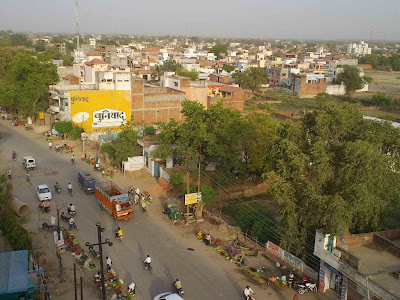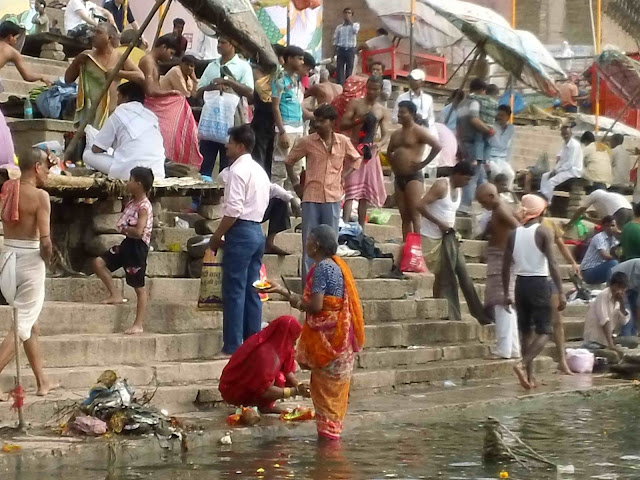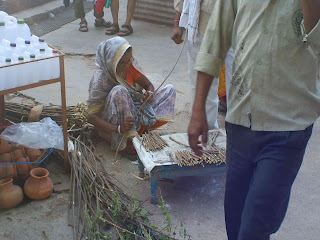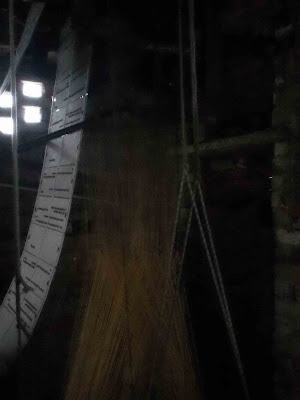 |
| Playing Guitar with the Nepalese guys |
 |
| Temple stairs |
 |
| Crowds at the temple watching dancers/musicians |
 |
| Temple dog under butter candles |
 |
| Give money and that guy (playing Buddha) will bless you! |
 |
| Sue sees eye to eye with God |
 |
| Temple Gate |
 |
| Les and winged lion (St. Mark's lion?) |
 |
| Mantras carved in the rocks |
 |
| Famous image of Buddha's eyes |
May 6 continued—Buddha’s Birthday! Instead of a direct, one-hour flight to
Katmandu, we went through Delhi. There
was a man with a nicely decorated sign who picked us up and took us to a place
in the tourist area of town. A flurry of
activity offering us a guide and a car to the monkey temple ensued, and while
Les went to get some money I talked to the neighboring guys and played guitar
with them. They said that we could walk
to the temple, or take a taxi for a small amount. Information is power. We decided to go on our own, but the guide
said he lived nearby and he would go with us.
He lead us around to every cranny in that beautiful temple. I can now imagine what was going on at all
those ruined temples: Mayan, Greek, the ones in Jordan, etc., because it was a bustling
place for everyone. Folks were paying
priests for blessings and received a bindi of rice, red dye and leaves. Also they got water sprinkled on them and
leaves put on their heads. Many were
lighting butter candles, some playing drums and others dancing, face painting,
begging, asking for monetary help for a daughter with a bad kidney, spinning prayer
wheels to let the prayers out into the world, looking out over Katmandu with
binoculars from the top, tossing coins into Shiva’s pot in the middle of a
fountain, putting forehead to icons, touching holy things and then chest and
forehead, chanting, even breakdancing.
Prayer flags and Buddhist color flags hung everywhere, the famous temple
with the eyes shown brightly with gold leaf.
Tons of people—young and old—climbed all those stairs lined with images
of Buddha, lions, dogs, stupas and railings.
Our young friend Raju helped us receive blessings, showed us how to do
rituals, and guided us through all the points in the temple. He was very enthusiastic.
We heard that the river near Pokhara (where we’re going tomorrow) had a devastating ice dam at the glacier break and a flash flood crashed
down the valley killing some people. In
the newspaper they had the count of those missing: 150 people, 45 cows, 80
goats. When I expressed how funny it was
to list the animals, the Nepalese didn’t find it funny, but explained that
people lost their animals. That’s
important.
 |
| Dinner and Nepalese entertainment |
Back in the neighborhood, we wandered down alleys with
restaurants, and settled on one with a four-piece Nepalese band. I loved the music and the smiles of the
flirtatious musicians. I had my first
beer in months, it seems.
 |
| Clutch start a tourist bus? |
May 7—We got up to see the sun rise from the roof. There was a nice view over Katmandu, but no
breakfast as promised. We arrived at the
desk at 6:15 as requested, and by 6:30, they said that the driver will not come
and to take a taxi to catch the bus. We
rushed to the bus stop (busses lined up on the street) and paid the driver. We were placed in the back row seats. Ugh.
Other folks were told to be here, but said no, and ended more up
front. We moved up too, but were ordered
back. The bus wouldn’t start. They tried all kinds of things, including
clutch starting it while a bunch of men pushed.
At the bottom of the hill intersection, I think they got some parts
(fuel pump?) and eventually got the bus to start on its own. It wasn’t too bad. Lunch was a typical Nepalese: rice, fried
dahl, curry and some noodles with veggies at a stand that also sold good
lassis. A man who had waited about 2
hours picked us up.
 |
| Pokhara hotel and boss (on left) |
 |
| Canoe to the temple on the island |
Our hotel was nice
and clean, but sporadic electricity, so my computer would drain quite quickly. After a nap, we walked down to the lake where
the locals were taking people out to the temple on the island in brightly
painted multi-colored boats. The climate
was very active, and the canoes were loaded to the gills. There
were cranes of some sort nesting in the bamboo groves. One would get a bent stick and give it to the
other who would jam it in the nest and wiggle it around until satisfied. There must have been a hundred nests and
twice as many squawking, smelly birds.
 |
| Our guide Him Lal, walking the hills for 20 years |
 |
| View from the hillside |
 |
| Water retention walls to avoid flood damage |
 |
| Mountains from on high
|
May 8—We arrived at the desk at 2:00 PM as requested, and
apparently they didn’t have a guide ready for us. They called Him Lal, and he was here in 10
minutes with dress clothes and hiking shoes to take us up a great hill to a
very pointy peak nearby. The walk was
steep, but mostly had stair steps to help us climb. Les burst forth; I was the slow one. Him Lal tried to stay between us, picking
little sweet yellow raspberries along the way.
We lost and drank plenty of water as we passed retention walls for
sudden floods of rain, schools, tiny family farms with cute baby animals,
houses that open up into a restaurant or guest house if you like, and rice
paddies and corn fields. Everyone
greeted us with palms together, “Namaste.” (“The light in me sees the light in
you.”) We stopped at a viewpoint where a
couple of men in Nepalese hats sat to watch the sun go down, and looked at fish
farms on the lake, with canoes way down low, and mountains stretching as far as
a human could see in the mist.
 |
| Sunrise over Himalayas! |
At dusk,
we arrived at the top village called Sarangkot; Him Lal took us to his friend’s
hotel. (He invited us to stay at his parent’s
house to experience a homestay, but we decided we wanted a shower instead—I
never thought I would hear that from me. The electricity was off, the shower was at the
end of the hall, and was a garden tap at chest level coming out of the wall
into a black (it looked slimy to me) cement corridor. Next door had a sign, “24 hour hot
shower.” It was a perfect spot. Him Lal took us up to the place where we
could see the sunrise over the big Annapurna Range in the morning. The steps seemed insurmountable—legs shaking;
but when we got there, WOW, we looked down on that valley that had the big
flash flood and more. We stayed until
our sweat chilled us, and went back to a nice meal at the hotel. I prayed to see the Himalayas in the morning—this
is why I came to Nepal!
 |
| Through the binoculars... |
 |
| The Himalayas! |
May 9—We woke 4:45 and were up on the lookout at 5AM. There were many tourists, so the salespeople and
the boys who wanted money to buy balls for their boys club were out, and cafés
were open. We paid our 25 cents to
enter, take a gander at Shiva’s temple, and sit for the show. Soon, light from an unseen sun lit up some of
the peaks. They looked like floating
teeth. I was so happy to see them finally. Binoculars revealed blowing snow on the tops.
Suddenly the Japanese tourists gasped and clapped at the bit of sun that
appeared from behind the cloud. The
light kept changing until the mist blurred almost everything.
We went down for porridge with apple and banana, paid our
bill, made friends with the dog and chickens, and we were on our way.
 |
| Three little girls to school are we... |
 |
| Our hotel (and restaurant) (and store) on mountaintop |
 |
| Men's hang out |
 |
| Morning hair braiding
|
 |
| Les makes friends |
 |
| School girls on the trail |
 |
| Man takes home a new goat. (Arranged marriage?) |
 |
| Hay stack |
 |
| Hay stack with legs |
 |
| Maoist party writes to keep the national army strong |
 |
| Gutter water collection system |
 |
| Farmers use terrace approach |
Today’s trek took us along a ridge between
two towns, much of it on a dusty road that made clouds with each step around
our knees. I remember people who trekked
in Nepal saying that basically you walk from one village to another. I see what they mean now. Instead of a wilderness situation, people
walk the roads. Men walk their new goats
home. Schoolgirls walk to school in
their skirt, shirt, tie and red bows in their newly combed hair. Some engaged with us, and of course asked us
for chocolate, money and school pens. They
were charming. As we walked, we talked
with Him Lal about politics; there are over 100 political parties that don’t
get along. The Maoist party is the most
powerful party and promised new schools and roads and better conditions, so
they were voted in. He says now the
promises are empty, and he thinks another party will get the vote soon—maybe the
Democratic Party? We talked about his arranged marriage and how he would handle his own sons' marriage: 1/2 and 1/2 love and arrangement. We saw more animals,
lots of people in their homes –some bathing behind short walls next to their
buffalos, big ponds for the animals and laundry, a jerry-rigged gutter using a
plastic 7-up bottle to help divert water to the cistern, coffee trees, wild
marijuana, neighborhood water spouts and kids yelling “Helloooooh” from the
doorways. Dad would have chuckled at the
resourcefulness of these people. I loved
the pace of the walking on the gentle slopes.
We got to the bus stop and met two Tibetan refugees. They talked about the oppressive conditions under
which they live. They have no
citizenship, nor do the children who are born in Nepal. One of them said their father had a “Free
Tibet” shirt on, and he was taken into custody, scared of harm and legal
bullying and was told he couldn’t wear such a thing. They have no land, so they cannot farm, and
must sell crafts to be able to buy food.
One man said it wasn’t much better than when they left China, and that
he might go to India where people are freer if it doesn’t change.
We got on a very crowded bus, and I worked out my biceps on
the curvy road trying to stay standing. Then we took a car to the hotel, tipped Him
Lal, took showers and dragged 4 kilos of clothes to the laundry across the
street. She said if she had electricity
she would have it tonight. If not, she
would have it in the morning.
 |
| Transport strike, walked and wheeled our luggage to airport |
 |
| Himalayas above the airport |
May 10—We were up early to pack, grab breakfast and set off
at 7AM, only to discover there was an overall transportation strike: no bus or
taxis--but planes were running. We asked
the desk to purchase some plane tickets for us.
“We’ll call you after they open at 8.”
I went down after 8 and they said that all the Russians need to go to
Katmandu, and that he’s chartering a plane for us all. He’ll let me know how much. “I’ll call you after 10.” No call, but later, he said we have tickets
for a 4:00 plane, to leave here at 3:00.
Later he said we have a 3:00 plane and to leave here at 1:30. At 1:30 they rushed us out to walk to the
airport. It was strange and wonderful to
have only foot traffic and an occasional motorbike or police vehicle. We checked luggage, went through the women’s frisking
gate and waited. It turned out to be a
4:00 plane, but the weather was getting worse, electricity went out, and then came
the cancelation announcement. Eventually
we were assured that we had tickets on the 7AM flight. (They wrote on a little piece of notepaper
the number of the plane and the manager’s name as proof of having a ticket.)
 |
| "Fishtail" Mountain from hotel |
 |
| Sunrise from Pokhara's airport |
We went across the street to a different Holiday Inn (not
the franchise), where they offered us a room for $30. A much simpler room was $17 and it was
nice. A young man from the airport
helped to get us a discount. We had to
pool all our rupees to get the room. Though the storm was still approaching, the Himalayas were
clearing. I ran up to the rooftop to
gaze at them as the sun went down. Overwhelmed with gratitude, I spent time
watching the subtle changes of light and cloud on the Annapurna range,
AHHHHHhhhhhhh! Later when a hotel guy
asked how was dinner, I said we spent all our money on the room and couldn’t
get dinner. In 10 minutes we heard a
knock at the door, and the management said that they would like to bring us complementary
dinner. I was so touched! We asked for something simple. “You can order anything.” Some vegetables and
rice? “You like Nepalese food?” Yes!
Soon we were spooning bean soup, rice, spicy sauce, pickled peppers,
some greens and potato/green beans into delicious bites. We certainly left with a sweet taste for
Nepal on our palates!
 |
| Our new Russian friend, Galya |
 |
| Finally getting on the small plane |
May 11—We forgot that we had to pay for exit tax, and we had
no more rupees. The cafeteria upstairs
gave us change. After we got our
boarding passes we went back to the rooftop café and sipped chai and coffee as
we gawked at the beautiful Himalayas. There
was fog in Katmandu, so our plane was 45 minutes late, but we had such a nice
conversation with some of the Russian tourists!
We only had to walk about 50 yards to the international airport. Because of the transport strike people were
asking if we walked there from town; one man said he went 2 hours in a bicycle
rickshaw for a huge price to get to the airport! We are SO lucky that yesterday did not go as
planned.
 |
| Up in the clouds with the mountaintops... NEPAL! |































































































